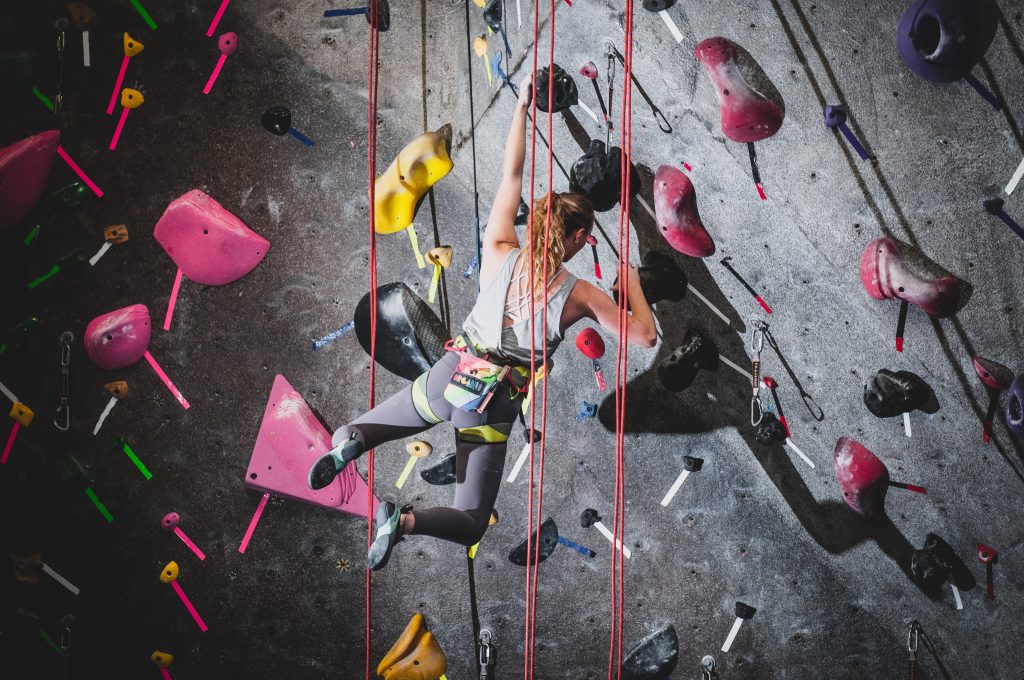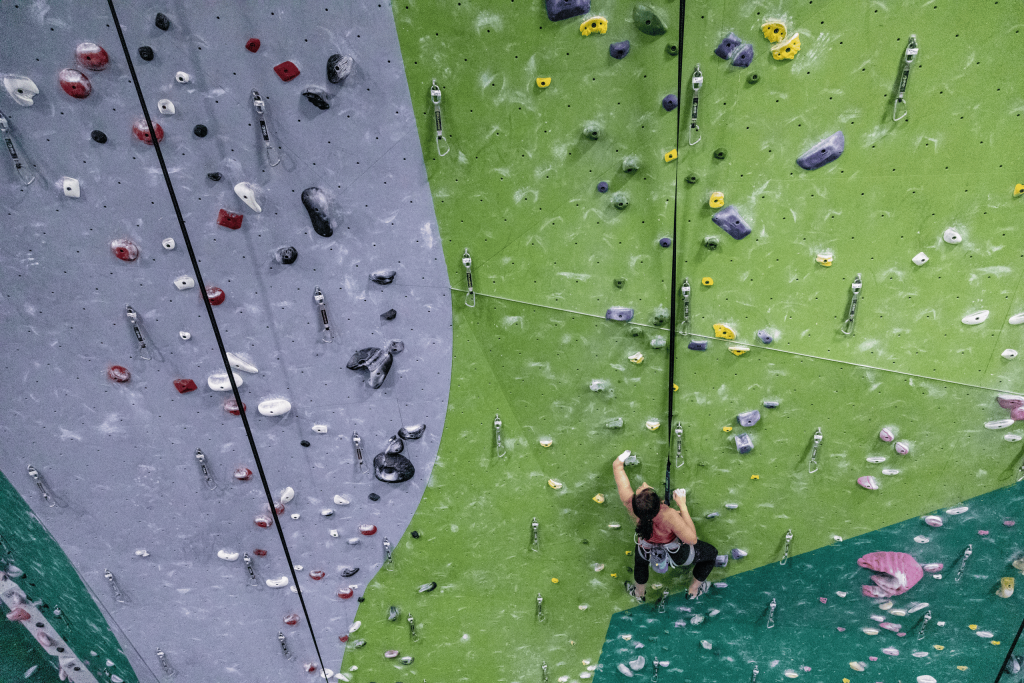The Olympic record for men’s speed climbing was set by Bassa Mawem in the sport’s inaugural event in 2021. That mark currently stands at 5.45 seconds. Less than three years later, Samuel Watson set the men’s speed climbing world record time of 4.798 -- a whopping 13.6% improvement on the Olympic time.
That may not sound like that much, but just for fun, if you applied the same 13.6% improvement to, say, Usain Bolt’s 100m pace from 2009, that would put the new 100m world record time at an incomprehensible 8.4 seconds!
Before you start coming up with all of the reasons why that comparison is totally preposterous, let me just say for the record, I agree with you. The 100m dash has a long and storied history, especially compared to a young, upstart sport like speed climbing. What’s surprising isn’t that speed climbing records have improved over time, but how drastically and how regularly those times have plummeted in such a short amount of time.
If you haven’t checked in on speed climbing since the last Olympics, let’s just say that the sport is having a serious moment. Times are dropping at an unprecedented rate in both the men’s and women’s races. For men, the five second barrier has been shattered. On the women’s side, it’s only a matter of time before someone goes sub-six.
Watching elite speed competitors like Samuel Watson climb the standard route boggles the mind. Getting to the top of the 15m, overhanging, 5.11-(ish) route in 4.798 seconds is completely absurd.
What’s really going on here? How have speed climbing times gotten so much faster in such a short period of time?
We talked to the world record holder Samuel Watson and former US record holder John Brosler to try to get to the bottom of the latest speed climbing revolution.
What’s changed in speed climbing?
The most obvious change from the Tokyo Olympic Games has been the introduction of speed climbing as a standalone Olympic competition. When sport climbing was first introduced in 2020, the speed event was one third of a combined format that also included lead climbing and bouldering.
The initial inclusion of speed climbing at the 2020 Olympics raised more than a few eyebrows amongst the larger climbing community and sent top climbers scrambling to learn the largely unknown discipline in time for the Olympic qualifiers. With the exclusion of women’s gold medalist Janja Garnbret (who was destined to win gold, no matter the format), the results from the speed portion of the competition had an enormous impact on the overall standings.
Looking at it in a slightly different light, the combined format did more than simply change the results of the sport climbing competition, it also significantly altered the field of climbers who qualified for the competition. In other words, the best speed climbers in the world did not compete in the 2020 Olympic Games.
The Speed Climbing Revolution
The exclusion of the world’s top speed climbing specialists from the Tokyo Games still doesn’t tell the whole story. The men’s speed climbing world record at the time was 5.20 seconds, set by Indonesia’s Veddriq Leonardo. In comparison, Mawem’s Olympic record time of 5.45 was not that far off the world record pace.
Since that time, however, the speed climbing specialists have taken things up a notch, ripping off outrageously fast results in this year’s Olympic qualifier series. Consider this: at the final Olympic qualifier event in Budapest earlier this spring, the cutoff for making it out of the qualification round (not to qualify for the Olympics, just to make it to the next round!) was 5.23 seconds. Even more incredibly, four different competitors recorded sub-five second times: Indonesia’s Veddriq Leonardo and Kiromal Katibin, Kazakhstan’s Amir Maimuratov, and China’s Wu Peng, who went on to win the competition (Samuel Watson didn’t compete in the event, since he had already qualified for Team USA).
It’s not only that we’re seeing speed specialists splitting from the combined format or that the talent pool is growing, the best speed climbers in the world are continuing to improve. Given the fact that speed climbing was already the fastest race in the Olympics, you have to wonder: how on earth are they doing that?!
Is it the Beta or the Training?
There are two main schools of thought when it comes to optimizing speed climbing performance: climb smarter and get stronger.
Since speed climbing is performed on the same route, tiny upgrades in beta can be the difference between breaking the world record and failing to make it out of the qualification round. If there’s one person who understands the modern evolution of speed climbing, it’s John Brosler. Between his time on the youth and elite circuits, John is a 10 time US National Champion and, prior to Sam Watson’s recent tear, the US men’s speed climbing national record holder.
“I think the biggest thing is beta for sure. Even though the athletes are faster now, if they were to do the old beta that people were doing in 2012, they would maybe be able to run fives, but definitely not fours.” -- John Brosler
When John Brosler talks about speed climbing beta, it’s worth listening. Innovative new sequences have come fast and furiously since 2021. Despite the limitations of a fixed speed route, the world’s top competitors continue finding ways to improve their strategies.
The second area for improvement (and let’s be honest, all of these climbers are constantly trying to improve themselves both mentally and physically) is a matter of speed-climbing-specific training regiments.
Speed climbing world record holder, Sam Watson, explains that it’s not just a matter of getting stronger. The growing popularity of the sport is also driving new resources and more dedicated training teams to support elite speed climbing athletes.
“As people get more interested in speed climbing and more climbers want to invest in it, they then put their selves and their talents towards that goal.”
“There are now so many full-time jobs in coaching and there are nutritionists and dietitians and all of these people that are supporting athletes that are also a factor behind how much success they're having.”
Unsurprisingly, Watson takes a scientific approach to his own personal training, as well. Rather than focusing on pure training volume, Watson strictly adheres to a strict series of strength and conditioning cycles, designed to put him in a brief window of peak physical performance, just in time for his next competition.
What is the fastest possible time in speed climbing?
The limit of what is possible in speed climbing is a matter of debate, even within the elite speed climbing community. For many years, the goal for many climbers was sub-five seconds. In April 2023, Veddriq Leonardo from Indonesia was the first person to clear the five second mark during an official competition. Since that monumental breakthrough, several other competitors have joined Leonardo in breaking the five second barrier.
The next big question that everyone is asking in speed climbing is: now what? How fast is really possible? We put this question to both John Brosler and Samuel Watson, and their answers were eerily similar.
Reflecting on over a decade competing at the highest levels of international speed climbing, Brosler has been at the cutting edge too long to even want to make a prediction.
“I don't even know because every time I pick a time, it gets broken. It makes me nervous to try. As far as I'm concerned right now, nothing's off the table.”
After a momentary consideration, however, he backtracked on that statement. In a race that can come down to thousandths of a second, it’s hard to ignore the allure of whole numbers. Considering we’re only a year removed from the five second mark finally being broken, the thought of someone climbing sub-four is simply too incredible to be believed.
“If we saw a three, that would be crazy. I don't think we would. I don't think we'll see a three.”
Watson’s response was only slightly more optimistic. As an enthusiastic basketball fan—more specifically a fan of his hometown San Antonio Spurs—Watson draws the parallel between speed climbing’s growing talent pool, and the way the international basketball talent pool has also expanded in recent years, seeing the emergence of NBA superstars like Luka Doncic, Nikola Jokic, and, his personal favorite, Victor Wembanyama.
“I have a plan to get to sub-4.55. That's my current goal. If there's new beta or there's an athlete that's seven feet tall and can jump 40 inches, maybe they could even push sub-four.”
Speaking as a fan of both climbing and basketball, I think it’s safe to say that getting the 7’4” Wembanyama onto a speed wall is something we would all like to see. If the two athletes happen to cross paths at the Olympic Village this summer, Watson has already offered to show him the ropes.



